
Copan
I visited the ruins of Copan on 8 days during our stay at Copan Ruinas. Somewhat confusingly the modern town is known as Copan Ruinas, though its real name is San Jose de Copan, rather than the archaeological site which is known as Las Ruinas. I’ll just use Copan for the archaeological site and ‘the Town’ for, well, the town from now on.
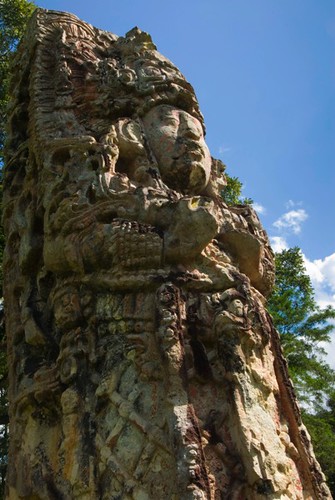
Stella H
Copan is the municipal park of Mayan cities compared to Tikal’s jungle fastness. The site is compact and the main area comprises a beautifully kept level lawn surrounded by trees that are reached by low yet very, very long flights of stone steps. This is the Gran Plaza that stretches north of the Acropolis. Perhaps the biggest comparison with anything in Britain is with the Yorkshire Sculpture Park.
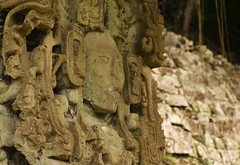
Stella N
For it is across this lawn that Copan’s biggest contribution to world culture or tourist attraction, depending on how you view these monuments, are arranged. These are ten massive stone sculptures of the Kings of Copan. Such sculptures, known as stelae, are a feature of Mayan religious and socio-political art. A stela depicts a king or major city event and is inscribed with Mayan hieroglyphs that convey the important person or event the stela was made and erected for. There is always an altar in front.
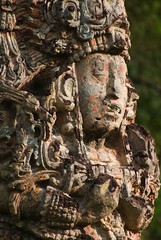
Stella H
The stelae of Copan are one of the biggest and best-surviving Mayan groups anywhere. Their real importance is that deep relief carving was not taken to such a high artform anywhere else in the Mayan world. This is in part due to the volcanic stone that is hard when first quarried then hardens on exposure to air to create a very long-lasting rock. Nearly all other Mayan cities are on limestone and the carving never reached the same depth of relief or survived the elements for long.

Is that a rabbit?
There are stelae throughout the whole of Copan but it is in the Gran Plaza that they are closely arranged. Seven of the ten were erected and so depict one king – known as 18 Rabbit because of the lupine resemblance of one hieroglyph. Over a number of years he created a procession route for public ceremonies that is now the de facto ancient sculpture park. Each is about twice the height of a person and bare the king dressed in religious costumes tailored full of cosmological meanings. It looks like he is tweaking his nipples while blessed out on a Class A drug. In fact he is holding a staff across his chest from the ends of which exit the sun deity in various anthropomorphic forms. His face is below a mask, which on each stelae represents a different god, and is surrounded by other deities. One has two stylised macaw beaks, which some earlier ‘scholar’s took for elephant trunks and evidence for cross-Pacific communication.
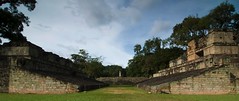
Ball Court
The other two main features of the plaza are the ball court and Hieroglyphic Stairway. The ball game was played throughout ancient MesoAmerica and involved teams using their hips, chests and shoulders to throw a solid rubber ball onto sloping stone sides with the aim of scoring through a hoop while watched from above by the nobility. The game re-enacted Mayan cosmology such as the passage of the sun through the Underworld and winning or losing teams either forfeited jewellery or their lives in sacrifice to the gods. The Stairway comprises glyphs written on the individual blocks of the steps and is the longest piece of ancient Mayan text.
South of the Plaza des Estella rises the stone Acropolis, an artificial mountain aligned on the cardinal points. Here is the heart of kingship and government in Copan. Two raised plazas hosted more private ceremonies for nobility and the nine governors of the regions commanded by the city. All nine governors and the king would meet regularly in the Popol Nah, or Mat House, Copan’s town hall. It is called a Mat House because it was were leaders brought their mats to sit on in front of the person who had the right to sit on the very front mat. This form of council was the basic elder-led administration in any community and was replicated in Copan’s Popol Nah at the city-state level.
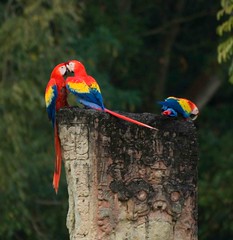
Macaws on a King
One of the delights of Copan is the group of ten or more semi-tame macaws that hang out near the ticker office and occasionally erupt into the plaza in a riot of colour and calls. They did this twice while I was there, once sitting on top of a stelae to search around and preen each other.
My week of photography at Copan was greatly enabled by Rene Viel, a French archaeologist who lives in Copan, and Oscar Cruz, the manager of the archaeological park. Oscar granted me a week's free access to the site and two museums as a result of Rene requesting access for me. Thank you to you both.
All-in-all, it was a very enjoyable week during which I got to know the personalities of Copan and hopefully have brought them out in the photographs.



No comments:
Post a Comment